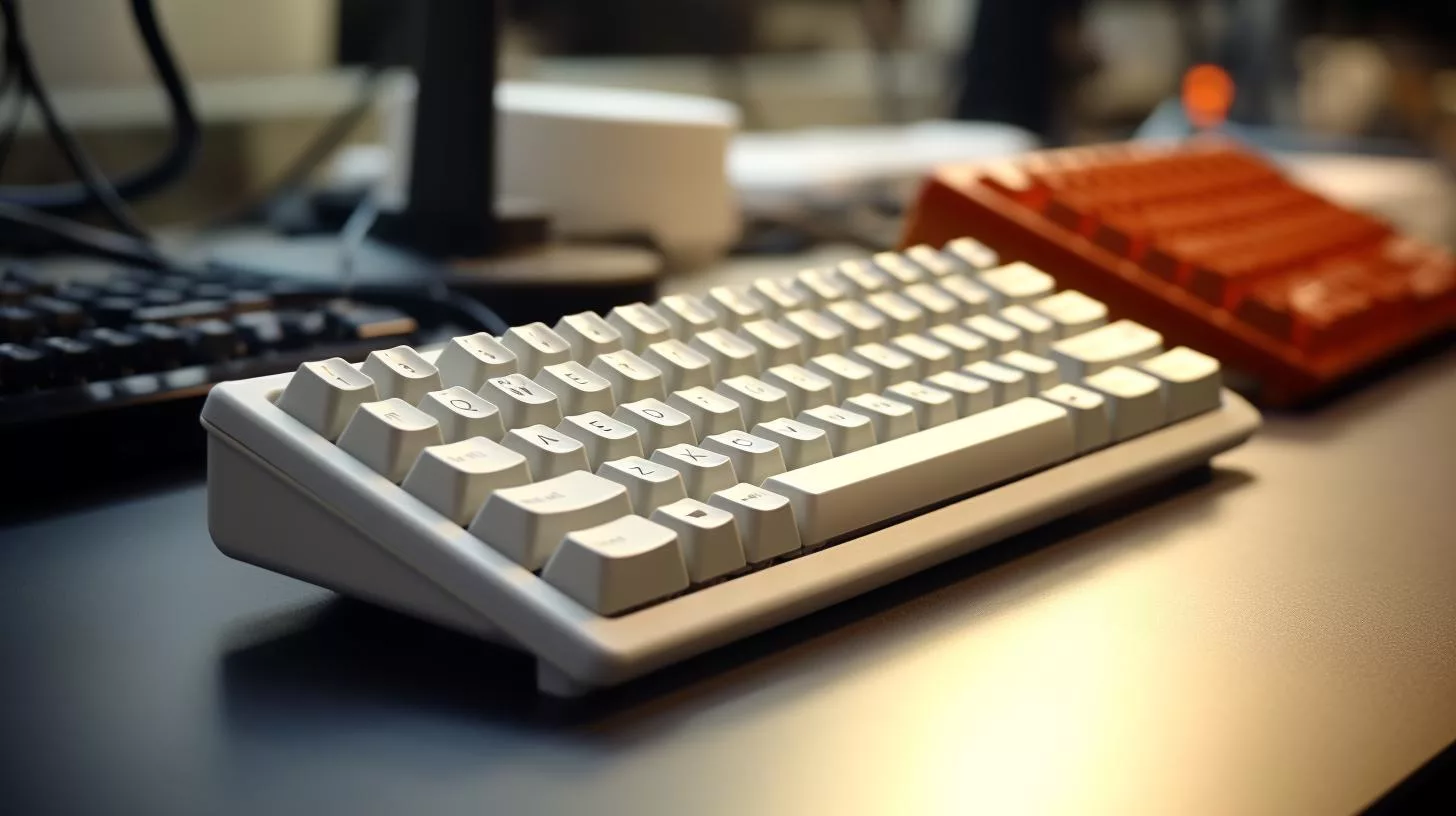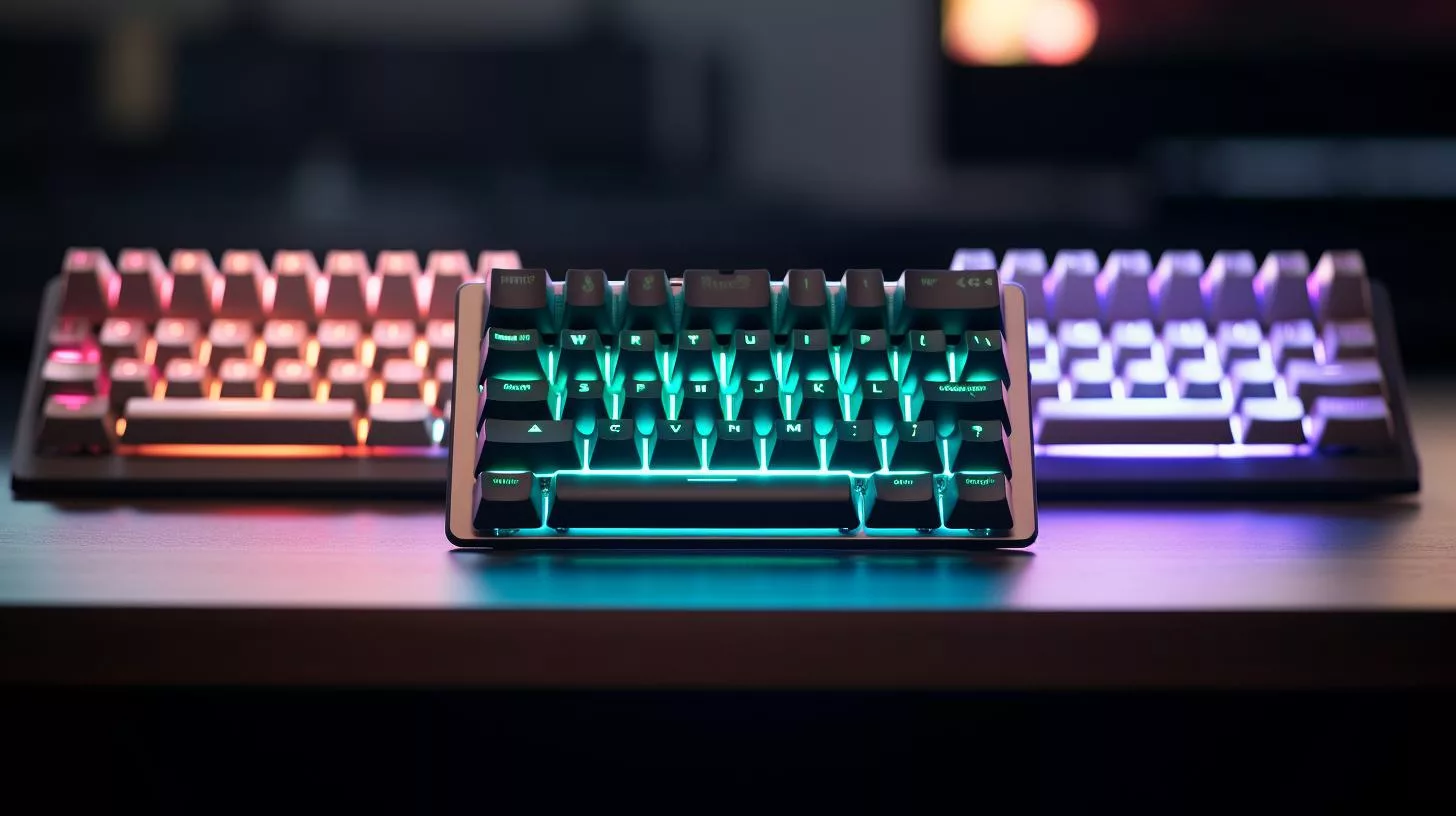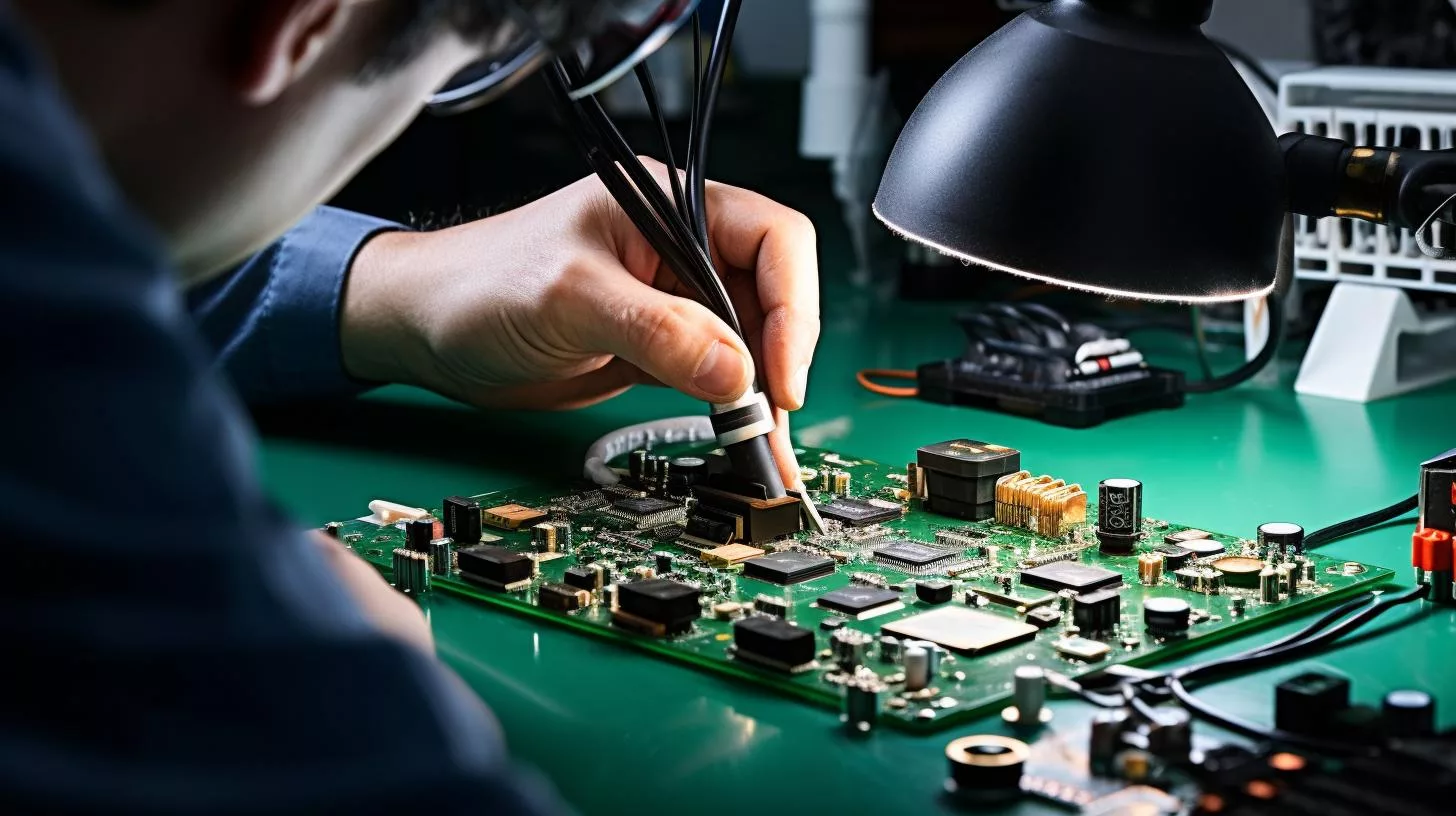Are you a tech enthusiast who values portability, customization, and minimalist design in your keyboard? Then you might have heard of 60% keyboards. These compact keyboards have been rising in popularity among gamers, programmers, and typists alike. But how many keys are on a 60% keyboard, and what are the advantages and disadvantages of using one? In this ultimate guide, we’ll explore everything you need to know about 60% keyboards, including popular models, building a custom keyboard, and cost considerations.
How many keys are on a 60% keyboard?
- A 60% keyboard typically has 61 keys
- It lacks dedicated arrow keys, function keys and numpad
- 60% keyboards are popular among gamers and for their portability and customization options.

What is a 60% Keyboard?
A 60% keyboard is a compact mechanical keyboard that typically lacks dedicated arrow keys, function keys, and number pad. Despite its small size, it offers the same functionality as a full-sized keyboard and is suitable for gaming and typing. A typical 60% keyboard has around 61 to 68 keys, including the alphanumeric keys. The top row and the second row both have 14 keys, while the third row has 13 keys, and the fourth and fifth rows have 9 keys each.
Compared to other keyboard types, a 60% keyboard has fewer keys than a tenkeyless (TKL) keyboard, which has around 87 keys, and a full-size keyboard, which has 104 keys. However, it has more keys than a 40% keyboard, which has around 40 keys and lacks many of the standard keys used for typing. It’s worth noting that the exact number of keys on a 60% keyboard may vary depending on the layout. For example, some 60% keyboards have a split spacebar, while others have a 7u spacebar.

Advantages of a 60% Keyboard
The popularity of 60% keyboards is due to several advantages they offer, including:
Portability
60% keyboards are compact and lightweight, making them ideal for travel and saving desk space. They’re easy to carry around, and some models even come with a carrying case. They’re also suitable for people who have limited desk space or prefer a minimalist setup.
Customization Options and Programmable Features
60% keyboards offer customization options, such as programmable keys, backlighting, and switch types. These options allow users to personalize their keyboards to their preferences and typing style. Some models even offer hot-swappable switches, which allow users to change the switches without soldering.
Ideal for Gamers and Streamers
60% keyboards are popular among gamers and streamers due to their compact design and portability. They offer the same functionality as a full-sized keyboard but take up less space on the desk. This makes them ideal for gamers who participate in esports tournaments or streamers who travel frequently.
Ergonomic Benefits of a Compact Keyboard
60% keyboards have a more ergonomic design than full-sized keyboards since they allow users to keep their mouse closer to their body. This reduces the strain on the shoulders and arms, making it more comfortable to use for extended periods.
Disadvantages of a 60% Keyboard
While 60% keyboards offer many advantages, they also have some disadvantages, including:
Lack of Dedicated Arrow Keys, Function Keys, and Number Pad
The main disadvantage of a 60% keyboard is the lack of dedicated arrow keys, function keys, and number pad. This can be a dealbreaker for users who rely on these keys for their work or activities. However, some 60% keyboards offer a function layer that allows users to access these keys through a combination of key presses.
More Difficult to Type on for Some Users
The compact size of a 60% keyboard can make it more difficult to type on for some users, especially those with larger hands. The keys are closer together, which can cause accidental key presses or mistyping. However, with practice, users can get used to the smaller size and improve their typing speed and accuracy.
Limitations for Certain Types of Work or Activities
Some types of work or activities may require a full-sized keyboard with dedicated arrow keys, function keys, and number pad. For example, data entry, accounting, or graphic design may require a full-sized keyboard with a number pad. However, for most general use cases, a 60% keyboard is sufficient.

Popular 60% Keyboard Models
There are many 60% keyboard models available on the market, ranging from pre-built to custom-built. Here are some popular models and their key features:
Ducky One 2 Mini RGB
The Ducky One 2 Mini RGB is a pre-built 60% keyboard that features Cherry MX RGB switches, PBT keycaps, and RGB backlighting. It also has a detachable USB Type-C cable and comes with additional colored keycaps.
Anne Pro 2
The Anne Pro 2 is a wireless 60% keyboard that features a custom software application, PBT keycaps, and RGB backlighting. It also has a detachable USB Type-C cable and supports both Bluetooth and wired modes.
Vortexgear Pok3r
The Vortexgear Pok3r is a pre-built 60% keyboard that features Cherry MX switches, PBT keycaps, and programmable keys. It also has a metal case and supports both Mac and Windows.
Custom-Built Keyboards
Building a custom 60% keyboard allows users to personalize their keyboard to their preferences and typing style. There are many resources available for building a custom keyboard, including guides, parts, and communities.

Building a Custom 60% Keyboard
Building a custom 60% keyboard can be a rewarding experience for those who want to personalize their keyboard to their preferences. Here are the steps to building a custom keyboard:
- Resources Available for Building a Custom Keyboard – Several resources are available for building a custom keyboard, including online stores, guides, and communities. Some popular online stores for parts include KBDFans, Drop, and NovelKeys. Guides and communities are available on Reddit, Geekhack, and Deskthority.
- Choosing the Right Parts – The first step in building a custom keyboard is choosing the right parts. This includes the case, PCB, switches, keycaps, and stabilizers. It’s important to choose parts that are compatible with each other and fit your preferences and budget.
- Soldering and Programming the Keyboard – Once the parts have been chosen, the next step is to solder and program the keyboard. This involves soldering the switches onto the PCB, installing the stabilizers, and programming the firmware. Some custom keyboards also require additional assembly, such as installing the case and attaching the keycaps.
Pros and Cons of Building a Custom Keyboard
| Switch Type | Brand | Characteristics |
|---|---|---|
| Cherry MX | Cherry | Tactile, linear, or clicky switches. Widely available and compatible with many custom keyboard parts. |
| Gateron | Gateron | Cheaper alternative to Cherry MX switches. Available in a variety of tactile, linear, or clicky options. |
| Kailh | Kailh | Cheaper alternative to Cherry MX switches. Available in a variety of tactile, linear, or clicky options. |
| Zealio | ZealPC | Tactile switches with a smooth, rounded bump. Considered high-end and more expensive than other options. |
| Holy Panda | Drop | Hybrid switches with a tactile bump and a pronounced sound. Popular among enthusiasts. |
Building a custom keyboard allows users to personalize their keyboard to their preferences and typing style. It also allows for more customization and flexibility than pre-built keyboards. However, it can be more time-consuming and costly than buying a pre-built keyboard. It also requires some technical knowledge and skills, such as soldering and programming.
Cost Considerations
The cost of a 60% keyboard can vary depending on whether it’s pre-built or custom-built. Pre-built 60% keyboards can range from $50 to $200, depending on the brand and features. Custom-built keyboards can cost upwards of $300, depending on the parts and customization options.
When considering the cost of a 60% keyboard, it’s important to factor in additional costs, such as keycaps, switches, stabilizers, and soldering equipment. Custom-built keyboards also require more time and effort to assemble and program.
Insider Tip: When building a custom keyboard, make sure to research and plan ahead to avoid compatibility issues and unnecessary expenses.
Personal Experience: Why I Switched to a 60% Keyboard
As someone who spends most of their day typing, I never thought I would consider downsizing my keyboard. But after experiencing some wrist discomfort, I decided to explore more ergonomic options and discovered the 60% keyboard.
At first, I was skeptical about the smaller size and the lack of dedicated arrow keys and function keys. However, after using it for a few weeks, I noticed a significant improvement in my wrist pain. The compact design allowed me to keep my hands closer together, reducing the strain on my wrists.
Additionally, the lack of dedicated keys pushed me to use more keyboard shortcuts, which increased my productivity and efficiency. I also appreciated the customization options and programmable features, allowing me to personalize my keyboard to my specific needs.
Overall, switching to a 60% keyboard has been a positive experience for me. While it may not be suitable for everyone, I highly recommend giving it a try, especially for those who spend long hours typing.
FAQ
What are the advantages of using a 60% keyboard?
The advantages of using a 60% keyboard include portability, customization options, ergonomic benefits, and suitability for gaming and typing.
What are the disadvantages of using a 60% keyboard?
The disadvantages of using a 60% keyboard include the lack of dedicated arrow keys, function keys, and number pad, difficulty typing for some users, and limitations for certain types of work or activities.
How much does a 60% keyboard cost?
The cost of a 60% keyboard can vary depending on whether it’s pre-built or custom-built. Pre-built 60% keyboards can range from $50 to $200, while custom-built keyboards can cost upwards of $300. Additional costs, such as keycaps, switches, stabilizers, and soldering equipment, should also be factored in.
60% keyboards offer a compact and customizable alternative to full-sized keyboards, making them ideal for gamers, programmers, and typists who value portability and minimalist design. While they have some disadvantages, such as the lack of dedicated keys, they offer many advantages, such as ergonomic benefits and customization options. Whether you’re looking to buy a pre-built or custom-built keyboard, make sure to research your options and consider the cost and compatibility of the parts.
